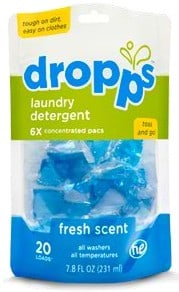Last Updated on October 12, 2024 by
Organic Laundry detergent – It is easy to overlook when you’re taking steps to be greener; laundry detergents in its own category.
It’s not quite a personal care product like toothpaste and deodorant, but it’s also not a cleaning product like a floor or toilet bowl cleaner.
We are always looking to eliminate toxins and pollutants from our homes.
What is something to consider when looking for the best green laundry detergents?
Know that laundry detergents and soaps can contain ingredients that are harmful to your health.
It is important to consider that you’re exposed to them every day through the clothes you wear.
Unfortunately, it’s hard to know exactly what’s in organic laundry detergent because, as with cleaning products, companies aren’t required to tell consumers what’s in them.
When there are products that you use often, it is worth considering paying a bit more to be sure they are as safe as they can be.
Learn more here by reading Organic Laundry Tips to Save Energy and Money and Top Green Cleaning Products
Tips for finding organic laundry detergents
- Avoid detergents with chemical fragrances and perfumes (avoid dryer sheets, too).
- Seek out a detergent brand that lists its chemicals, or stick with a green brand you trust.
- Skip detergents that might contain phosphates (harmful to waterways after use), parabens (hormone disruptors), and nonylphenol ethoxylate (endocrine disruptor).
- Make sure the bottle or box you buy is recyclable and, preferably, recycled.
- Check the amount you need to use per wash. Using less is always better.
Review of best green laundry detergents
We always prefer unscented detergents, whenever possible.
Unfortunately, most companies include scents which mean more chemicals.
Rain Laundry Detergent & Organic Fabric Softener:
For those with skin disorders or with children, this may be your best bet.
[easyazon_link identifier=”B00KAMHLPA” locale=”US” tag=”gogreentravel-20″]Rain’s Laundry Detergent[/easyazon_link] is actually 100% detergent free.
Your children’s glands won’t absorb the enzymes from their towels after showering — when pores are open — and from their clothing — when sweating — found in traditional detergents.
Everything in this product is sourced from USA too!

Dropps:
Dropps sent us samples of the scent / dye free and the fresh scent detergents.
Dropps are phosphate free, NPE-free, and chlorine free.
It is made of “biodegradable plant-based surfactants (anionic and nonionic)” according to the ingredient list.
Because they come in “toss-and-go” packs there is no jug to recycle; though the plastic packaging does need to be thrown in the garbage.
Lastly, they were recognized for safer chemistry by the EPA.
Overall, we found Dropps worked quite well for cleaning our laundry.
We definitely preferred the scent-free over their “fresh scent” line as it was a little overpowering.
But know we are biased in that we don’t like scents!
[easyazon_link cloaking=”default” keywords=”dropps” localization=”default” locale=”US” nofollow=”default” new_window=”default” tag=”gogreentravel-20″]BUY DROPPS HERE[/easyazon_link]
Trader Joe’s Laundry Detergent:
We have used the Trader Joe’s Liquid Laundry Detergent for several years.
It has a lavender scent that has just enough fragrance without being overpowering.
The detergent works well for day-to-day use, but for tougher stains non-green detergents do a better job.
Kirkland Signature Ultra Clean Premium Laundry Detergent:
Costco’s laundry detergent is phosphate-free, dye-free, and perfume-free.
What’s more, the container is made from 25% or more recycled materials.
Vaska Laundry Detergent:
This brand of detergent contains plant-based surfactants and conditioners, lavender extract and filtered water.
It does not contain: “NPE’s carcinogenic ingredients, chlorine, phosphates, petroleum products, alcohol, optical brighteners, synthetic scents, animal ingredients, EPA priority pollutants, or materials listed by ACGIH as hazardous.”
Makes you wonder what’s in your detergent – doesn’t it?
How to make your own laundry soap
There is always the option of making your own laundry detergent.
It is like baking a cake or bread from scratch: You will know exactly what is in it.
With some simple washing soda, Borax (which is made from naturally-occurring ingredients) and an unscented and natural bar of soap, you can be on your way to a more environmentally-friendly and green laundry detergent.
Living more green
For more information on environmentally friendly and eco living:
Green Spring Cleaning Checklist: 8 Tips for Your Home
What Makes a Home Eco
The best green laundry detergents don’t necessarily cost more and you will have less irritants and toxins in your home and on your skin.
It’s a good idea to research on the Good Guide to learn more about the laundry detergent in your home.
Green Laundry Tips to Save Energy and Money
Since the new year, I’ve been doing my best to live green according to my top resolutions for green moms.
I’ve cut several energy-wasting activities from my daily routine, but laundry remains my nemesis.
With a family of five (including three growing boys who all play sports daily!), large quantities of laundry will be a reality for me for the foreseeable future.
Laundry is probably a reality in yours as well.
While household laundry can’t be avoided, there are ways to reduce energy, water-consumption, and reduce your environmental impact with the following five green laundry tips.
Green Laundry Tips: Use Green Detergent
Yes, it’s more expensive, but eco-friendly laundry detergent helps more than just the environment.
The chemical-free stuff is gentler on kids’ skin, too.
The best, including my top three below, are free of dyes and scents (who needs it?) and utilize smaller packaging than most.
When selecting eco-friendly laundry detergent, search for the best ones by looking at what they don’t contain instead of what they do contain.
Laundry detergent manufacturers are not required by law to disclose their ingredients, so you’re likely to see vague ingredient lists instead of a run-down of harmful chemicals.
Look on the label for companies disclosing good things instead: what eco-claims they make.
Curious how your laundry detergent ranks?
Invest in spin dryer
During research for this article, I tested out an eco-friendly spin dryer from Laundry Alternative.
Approximately half the size of a traditional dryer, the spin dryer works in only 2-3 minutes, using far less energy for an average load.
It’s compact and gentler on clothes than your regular dryer, and has a pretty decent capacity given its size (13.8 pounds of wet laundry).
How the spin dryer works (and helps the environment):
You fill it with wet clothes, either straight from your washer or after a short cycle in your regular dryer.
You plug it in (uses a conventional 110V outlet).
You close the lid and watch the water drain out of the bottom.
You’ll want to place a small bowl or other item to catch the water on the floor.
In 2-3 minutes, you retrieve your clothes, which will be mostly dry.
They’ll still need to dry a bit more hanging in the closet or dry them in the regular dryer for a short time.
During a normal laundry cycle in my house, it takes me approximately 9 minutes to dry the clothes from my washer using the spin dryer (about three spin dryer loads from one washer load).
Then they all get tossed into the regular dryer for a shorter 20 minute cycle.
At that point, they’re completely dry.
The upside: I’m taking it easier on my clothes, and I’m saving energy.
The downside: I now have an extra step to take during my laundry chore.
Note: Laundry Alternative also has a travel-sized spin dryer, which works much like swim suit dryers do in upscale locker rooms.
It’s perfect for taking on the road in an RV or while camping, though would be too cumbersome to bring during air travel or short trips.
Skip the dryer altogether
If you have outdoor space and sunshine, you can use a spin dryer solo (without the traditional) or skip the dryer altogether.
Yes, you can hang your clothes outside like your grandma did, on a line.
I’ve seen this done more and more often in my Oregon neighborhood, and will consider it when the rain stops.
You can buy a clothesline for under $50.
Do less laundry!
Is it really dirty?
I ask my kids this all the time, after they’ve tossed a shirt into the laundry bin after wearing it for 15 minutes.
Now, most of the time, my boys’ clothes are as muddy and sweaty as you’d expect, but I’ve been teaching them to conserve on the laundry front when possible.
This means that items that don’t get very dirty, like pajamas, get two wears (or more) before going into the drum, and jackets and gloves are set out to dry instead of being tossed in the dryer.
Use energy-efficient appliances
You don’t have to use an eco-friendly dryer alternative to conserve energy.
Everyone knows to look for the Energy Star logo, but when shopping for a new washer or dryer, it also helps to know the following:
Top loading washers are less energy-efficient and use more water.
Stainless steel tubs can withstand faster spinning, which means shorter washing and drying times.
It’s better to buy a moderately-priced front loader than the highest end top-loader.
Environmentally Friendly and Eco living:
Environmentally Friendly Green Furniture
Green Spring Cleaning Checklist: 8 Tips for Your Home
What Makes a Home Eco
What do you do to keep your laundry practices eco-friendly?
Share your green laundry tips!
Photo credit: slgc and seanfreese.
